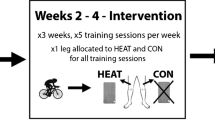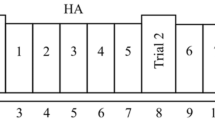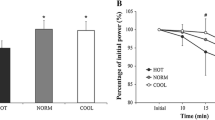Abstract
The purpose of this investigation was to determine the influence of heat stress on the dynamics of muscle metabolic perturbation during high-intensity exercise. Seven healthy males completed single-legged knee-extensor exercise until the limit of tolerance on two separate occasions. In a randomized order the subjects underwent 40 min of lower-body immersion in warm water at 42°C prior to exercise (HOT) or received no prior thermal manipulation (CON). Following the intervention, muscle metabolism was measured at rest and throughout exercise using 31P-MRS. The tolerable duration of high-intensity exercise was reduced by 36% after passive heating (CON: 474 ± 146 vs. HOT: 303 ± 76 s; P = 0.005). Intramuscular pH was lower over the first 60 s of exercise (CON: 7.05 ± 0.02 vs. HOT: 7.00 ± 0.03; P = 0.019) in HOT compared to CON. The rate of muscle [PCr] degradation during exercise was greater in the HOT condition (CON: −0.17 ± 0.08 vs. HOT: −0.25 ± 0.10% s−1; P = 0.006) and pH also tended to change more rapidly in HOT (P = 0.09). Muscle [PCr] (CON: 26 ± 14 vs. HOT: 29 ± 10%), [Pi] (CON: 504 ± 236 vs. HOT: 486 ± 186%) and pH (CON: 6.84 ± 0.13 vs. HOT: 6.80 ± 0.14; P > 0.05) were not statistically different at the limit of tolerance (P > 0.05 for all comparisons). These results suggest that the reduced time-to-exhaustion during high-intensity knee-extensor exercise following lower-body heating might be related, in part, to accelerated rates of change of intramuscular [PCr] and pH towards ‘critical’ values that limit muscle function.


Similar content being viewed by others
References
Allen DG, Lamb GD, Westerblad H (2008) Skeletal muscle fatigue: cellular mechanisms. Physiol Rev 88:287–332
Amann M (2011) Central and peripheral fatigue: interaction during cycling exercise in humans. Med Sci Sports Exerc 43:2039–2045
Bailey SJ, Fulford J, Vanhatalo A, Winyard PG, Blackwell JR, DiMenna FJ, Wilkerson DP, Benjamin N, Jones AM (2010) Dietary nitrate supplementation enhances muscle contractile efficiency during knee-extensor exercise in humans. J Appl Physiol 109:135–148
Banister EW, Cameron BJ (1990) Exercise-induced hyperammonemia: peripheral and central effects. Int J Sports Med 11(Suppl 2):S129–S142
Burnley M, Doust JH, Jones AM (2002) Effects of prior heavy exercise, prior sprint exercise and passive warming on oxygen uptake kinetics during heavy exercise in humans. Eur J Appl Physiol 87:424–432
Ch’en FF, Dilworth E, Swietach P, Goddard RS, Vaughan-Jones RD (2003) Temperature dependence of Na+–H+ exchange, Na+–HCO3 − co-transport, intracellular buffering and intracellular pH in guinea-pig ventricular myocytes. J Physiol 552:715–726
Drust B, Rasmussen P, Mohr M, Nielsen B, Nybo L (2005) Elevations in core and muscle temperature impairs repeated sprint performance. Acta Physiol Scand 183:181–190
Edwards RH, Harris RC, Hultman E, Kaijser L, Koh D, Nordesjö LO (1972) Effect of temperature on muscle energy metabolism and endurance during successive isometric contractions, sustained to fatigue, of the quadriceps muscle in man. J Physiol 220:335–352
Febbraio MA (2000) Does muscle function and metabolism affect exercise performance in the heat? Exerc Sport Sci Rev 28:171–176
Febbraio MA, Snow RJ, Hargreaves M, Stathis CG, Martin IK, Carey MF (1994a) Muscle metabolism during exercise and heat stress in trained men: effect of acclimation. J Appl Physiol 76:589–597
Febbraio MA, Snow RJ, Stathis CG, Hargreaves M, Carey MF (1994b) Effect of heat stress on muscle energy metabolism during exercise. J Appl Physiol 77:2827–2831
Febbraio MA, Carey MF, Snow RJ, Stathis CG, Hargreaves M (1996) Influence of elevated muscle temperature on metabolism during intense, dynamic exercise. Am J Physiol 271:1251–1255
Ferguson RA, Krustrup P, Kjaer M, Mohr M, Ball D, Bangsbo J (2006) Effect of temperature on skeletal muscle energy turnover during dynamic knee-extensor exercise in humans. J Appl Physiol 101:47–52
Gandevia SC (2001) Spinal and supraspinal factors in human muscle fatigue. Physiol Rev 81:1725–1789
González-Alonso J, Calbet JA (2003) Reductions in systemic and skeletal muscle blood flow and oxygen delivery limit maximal aerobic capacity in humans. Circulation 107:824–830
González-Alonso J, Calbet JA, Nielsen B (1998) Muscle blood flow is reduced with dehydration during prolonged exercise in humans. J Physiol 513:895–905
González-Alonso J, Teller C, Andersen SL, Jensen FB, Hyldig T, Nielsen B (1999) Influence of body temperature on the development of fatigue during prolonged exercise in the heat. J Appl Physiol 86:1032–1039
González-Alonso J, Crandall CG, Johnson JM (2008) The cardiovascular challenge of exercising in the heat. J Physiol 586:45–53
Gray SR, De Vito G, Nimmo MA, Farina D, Ferguson RA (2006) Skeletal muscle ATP turnover and muscle fiber conduction velocity are elevated at higher muscle temperatures during maximal power output development in humans. Am J Physiol Regul Integr Comp Physiol 290:376–382
Gray SR, Söderlund K, Ferguson RA (2008) ATP and phosphocreatine utilization in single human muscle fibres during the development of maximal power output at elevated muscle temperatures. J Sports Sci 26:701–707
Hogan MC, Richardson RS, Haseler LJ (1999) Human muscle performance and PCr hydrolysis with varied inspired oxygen fractions: a 31P-MRS study. J Appl Physiol 86:1367–1373
Jones AM, Wilkerson DP, DiMenna F, Fulford J, Poole DC (2008) Muscle metabolic responses to exercise above and below the “critical power” assessed using 31P-MRS. Am J Physiol Regul Integr Comp Physiol 294:585–593
King DS, Costill DL, Fink WJ, Hargreaves M, Fielding RA (1985) Muscle metabolism during exercise in the heat in unacclimatized and acclimatized humans. J Appl Physiol 59:1350–1354
Mohr M, Rasmussen P, Drust B, Nielsen B, Nybo L (2006) Environmental heat stress, hyperammonemia and nucleotide metabolism during intermittent exercise. Eur J Appl Physiol 97:89–95
Morrison S, Sleivert GG, Cheung SS (2004) Passive hyperthermia reduces voluntary activation and isometric force production. Eur J Appl Physiol 91:729–736
Nybo L, Nielsen B (2001a) Middle cerebral artery blood velocity is reduced with hyperthermia during prolonged exercise in humans. J Physiol 534:279–286
Nybo L, Nielsen B (2001b) Hyperthermia and central fatigue during prolonged exercise in humans. J Appl Physiol 91:1055–1060
Nybo L, Jensen T, Nielsen B, González-Alonso J (2001) Effects of marked hyperthermia with and without dehydration on \( {\dot{V}}{{\text{O}_{2} }} \) kinetics during intense exercise. J Appl Physiol 90:1057–1064
Nybo L, Møller K, Volianitis S, Nielsen B, Secher NH (2002a) Effects of hyperthermia on cerebral blood flow and metabolism during prolonged exercise in humans. J Appl Physiol 93:58–64
Nybo L, Secher NH, Nielsen B (2002b) Inadequate heat release from the human brain during prolonged exercise with hyperthermia. J Physiol 545:697–704
Parkin JM, Carey MF, Zhao S, Febbraio MA (1999) Effect of ambient temperature on human skeletal muscle metabolism during fatiguing submaximal exercise. J Appl Physiol 86:902–908
Pettigrew DW, Frieden C (1979) Rabbit muscle phosphofructokinase. A model for regulatory kinetic behavior. J Biol Chem 254:1896–1901
Starkie RL, Hargreaves M, Lambert DL, Proietto J, Febbraio MA (1999) Effect of temperature on muscle metabolism during submaximal exercise in humans. Exp Physiol 84:775–784
Taylor DJ, Bore PJ, Styles P, Gadian DG, Radda GK (1983) Bioenergetics of intact human muscle. A 31P nuclear magnetic resonance study. Mol Biol Med 1:77–94
Vanhamme L, van den Boogaart A, Van Huffel S (1997) Improved method for accurate and efficient quantification of MRS data with use of prior knowledge. J Magn Reson 129:35–43
Vanhatalo A, Fulford J, DiMenna FJ, Jones AM (2010) Influence of hyperoxia on muscle metabolic responses and the power-duration relationship during severe-intensity exercise in humans: a 31P magnetic resonance spectroscopy study. Exp Physiol 95:528–540
Wyss M, Schlegel J, James P, Eppenberger HM, Wallimann T (1990) Mitochondrial creatine kinase from chicken brain. Purification, biophysical characterization, and generation of heterodimeric and heterooctameric molecules with subunits of other creatine kinase isoenzymes. J Biol Chem 265:15900–15908
Author information
Authors and Affiliations
Corresponding author
Additional information
Communicated by David C. Poole.
Rights and permissions
About this article
Cite this article
Bailey, S.J., Wilkerson, D.P., Fulford, J. et al. Influence of passive lower-body heating on muscle metabolic perturbation and high-intensity exercise tolerance in humans. Eur J Appl Physiol 112, 3569–3576 (2012). https://doi.org/10.1007/s00421-012-2336-6
Received:
Accepted:
Published:
Issue Date:
DOI: https://doi.org/10.1007/s00421-012-2336-6




